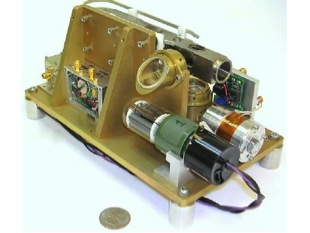Ion clocks
The electrically charged character of ions is both an asset and a drawback for making an atomic clock.
This is an advantage because it is easy to trap ions in an appropriate electromagnetic field for a long time, which allows to obtain long interaction times and consequently fine resonance lines. Moreover, the ions trapping on a confined zone makes it possible to overcome the first-order Doppler effect by being in the so-called Lamb-Dicke regime. Various ion trap geometries exist, and H.G. Dehmelt and W. Paul were awarded the Nobel Prize in Physics in 1987 for their pioneering work in this field.
The ions charge is also a disadvantage because the electrostatic interactions between ions induce a very significant frequency shift linked to the Stark effect. The only way to remedy this negative phenomenon is to trap only one ion, obviously at the expense of the signal-to-noise ratio and the frequency stability which depends on the number of ions being probed simultaneously. An intermediate solution consists in creating linear traps in which several ions are trapped along a line of minimum potential. Many developments of ion clocks have been carried out, in particular with the mercury ion Hg+, to achieve very interesting performances in small volumes (< 10 litres): stability of 5.10-14 for one second of integration and lower than 10-16 on long term.
Optical pumping and clock signal detection are performed by lasers, or by spectral lamps in simplified systems. The latter are very interesting for designing simple and compact systems but, in the mercury ion case, they operate in the ultraviolet, which causes reliability and resistance to the space environment problems. The Jet Propulsion Laboratory in the USA is, in particular, working on these clocks spatialization.

